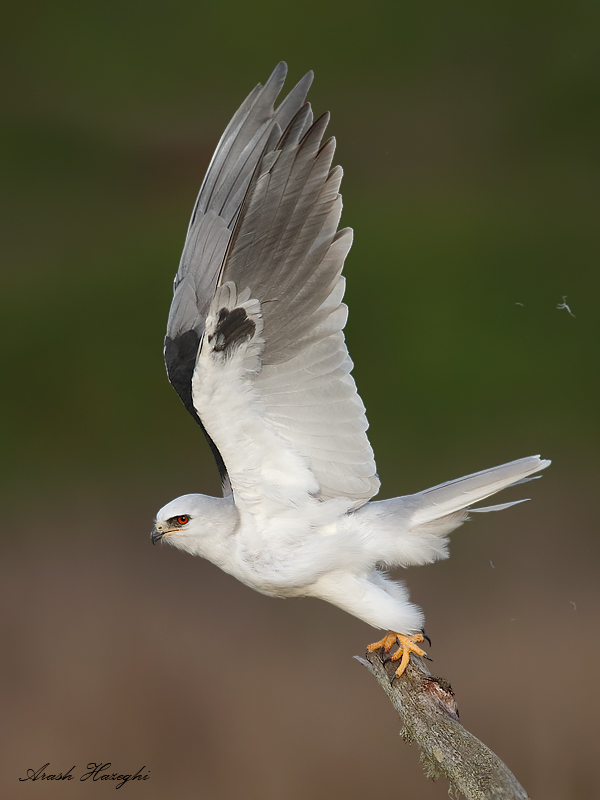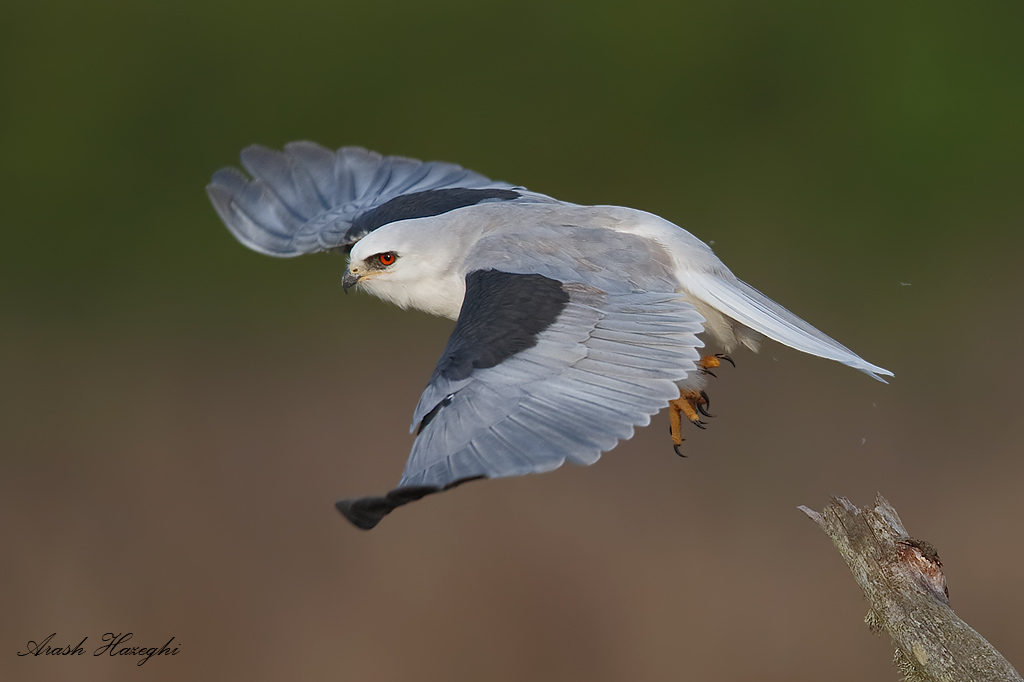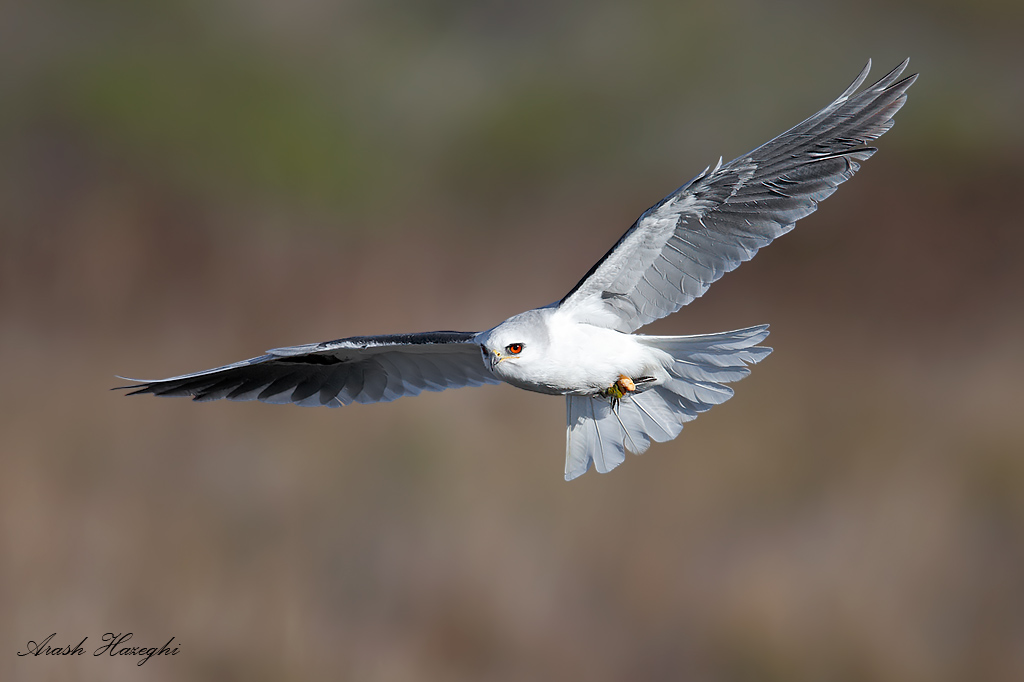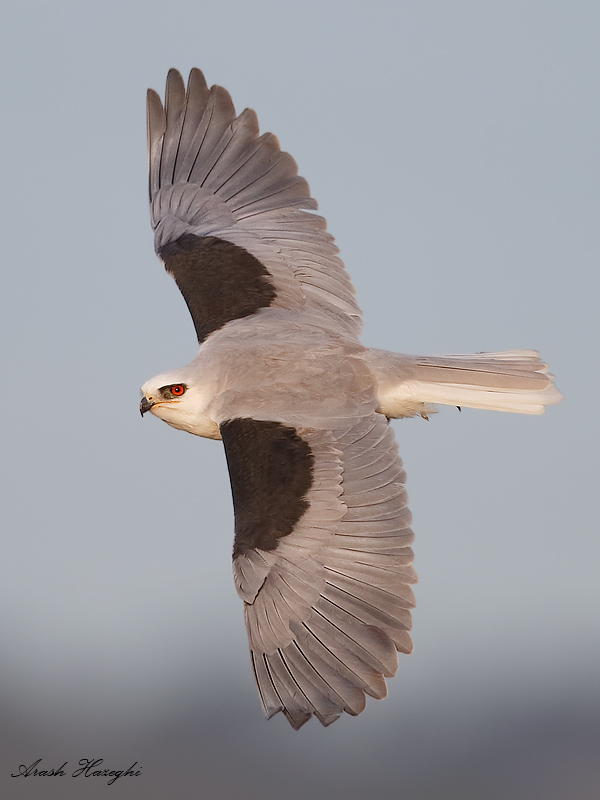
EOS 1DX field review and impressions
AF performance
Most of my photography is focused on flight shots of wild birds against varied backgrounds based on handhold super-telephoto technique. The handholding, acquisition and tracking skills of the photographer plays the most significant role in this method, but the camera AF performance also plays a major. Raptors fly fast and in erratic trajectories, so the photographer often has a single chance to lock focus on the subject at the critical time to capture the moment of peak action . I personally need AF that is very quick and accurate and can respond to my input in a fraction of a second. This is why I mostly use 1D series cameras. To this date, The EOS 1D Mark IV has had the best overall AF system that I have used. I had extensive experience with its AF system and it had helped me capture hundreds of dynamic flight images which constitute the majority of flight images in my portfolio. That is not to say the EOS 1D Mark IV AF was perfect in all conditions, but overall it seemed unlikely for Canon to significantly improve the already solid AF system.
The highlights of the new AF system include a 61-point sensor with up to 41 cross-type sensors (with select lenses) and 5 dual-cross sensors (f/2.8 only). With Canon super-telephoto primes at f/4 you get 41 cross-type sensors. When adding a 1.4X Extender MKII or MKIII to f/4 super-telephoto lenses 21 sensors will remain cross-sensitive at f/5.6. With firmware version 1.1.1 which was introduced after the camera’s release the center AF sensor remains active and cross-sensitive at f/8 (f/4 super-telephoto lens with extender 2X). If AF expansion is enabled the 4 surrounding points also remain active at f/8 but not selectable. Shown below is the EOS 1DX AF layout, superimposed on the EOS 1D Mark IV AF sensor grid. You can see that the EOS 1DX AF coverage is actually wider despite having a larger field of view due to its full-frame sensor. The details of the EOS 1DX AF system is published on Canon’s DLC website.

EOS 1DX vs. EOS 1D Mark IV AF coverage. The EOS 1DX has a significantly larger finder. Despite the wider field of view the EOS 1DX has a wider AF coverage thanks to its very large AF sensor.
When we compare the EOS 1DX specs directly to EOS 1D Mark IV, the most striking difference is the number of AF sensors with cross-type sensitivity. The EOS 1D Mark IV has only ONE cross-sensor at f/4 and none at f/5.6. The EOS 1DX has 41/21. However the number of cross-type sensors is only one factor in overall AF performance. For e.g. the EOS 7D also features 19 cross-type sensors at f/5.6, however its overall AF speed and precision falls considerably behind that of EOS 1D Mark IV for avian-in-flight photography.
According to my interview with Chuck Westfall, Canon USA’s technical adviser the EOS 1DX and the EOS 5D Mark III share the same AF module, however the servo drive speed for EOS 1DX is much faster than the EOS 5D Mark III due to its high-capacity battery pack which has a higher voltage. I purchased an EOS 5D Mark III when it first came out back in spring 2012 for the purpose of testing the new AF system. The new AF system proved quite capable (see one example below) especially in tracking and low-light performance. But overall it failed to provide the same level of experience compared to the EOS 1D Mark IV, mainly due to slow servo drive when coupled to 500mm and 600mm super-telephoto lenses (with and without 1.4X extender III), noticeable shutter lag and slow continuous shooting speed. Given these factors it was not possible to do an apple-to-apple comparison with the EOS 1D Mark IV. As a result I quickly went back to the EOS 1D Mark IV and gave up on the EOS 5D Mark III for flight/action shots.

Adult White-tailed kite. EOS 5D Mark III 700mm f/5.6 1/3200sec ISO 400, handheld. Click here to see an HD file.
When I first tried the EOS 1DX in the field, I immediately noticed the blazing fast servo drive. The servo drive is significantly faster than the EOS 1D Mark IV, especially when a tele-extender is attached. In fact I had to double check to see if I had an extender attached because unlike the EOS 1D Mark IV, I could not sense a drop in AF drive speed when the extender was attached. The focus just snaps onto target with the 1DX where as with the 1D Mark IV it rather glides onto the target. This allows rapid acquisition when raptors fly fast or when action happens unexpectedly.
It is extremely difficult, if not impossible, to devise a method for a controlled test of AI-servo performance between two bodies for an erratic subject such as raptors in flight as there are too many parameters. Instead, I attempted to photograph a subjects I had shot extensively before in various conditions and was familiar with, the white-tailed kite.
The EOS 1DX AF feels noticeably faster than the 1D Mark IV and does a better job with stability, i.e. it remains locked on the bird delivering a higher percentage of tack sharp files in a sequence when compared to the EOS 1D Mark IV. Below are some examples:

Adult-white-tailed kite take off. EOS 1DX 840mm f/5.6 1/2500sec ISO 1600 handheld. Click here to see an HD file.
AF stability remained good during flight.

Adult white-tailed kit. EOS 1D X, 840mm f/5.6 1/2500sec ISO 1600 handheld. Click here for an HD file.

Adult white-tailed kite. EOS 1DX 840mm f/5.6 1/2500sec ISO 1600 handheld. Click here to see an HD file.

Adult white-tailed kite. EOS 1DX 840mm f/5.6 1/2500sec ISO 1600 handheld. Click here to see an HD file.
One of the issues that I had with the EOS 1D Mark IV, was AF stability in AI-servo mode. Sometimes the camera would produce a soft frame in between two tack sharp frames for no apparent reason. I did not observe this issue as much with the EOS 1DX.
I also noticed that unlike EOS 1D Mark IV, the frame rate does not drop with EOS 1DX when tracking BIF. The camera appears to be shooting at 12 fps all the time while the 1D Mark IV sometimes slows down during action/tracking to allow for AI-servo to catch up, especially in low light conditions. Now it is easier to capture the peak of action frame thanks to consistent 12 fps. To get the best out of the camera you need to use the fastest CF cards on the market, and it is nice that Canon finally replaced the useless SD card slot with a second CF slot. Now you can double the capacity and not worry about having to replace your card in the middle of action!
In terms of field image quality, the EOS 1DX produces the highest quality output I have seen from any Canon body to this date. Its RAW files are very sharp and clean and color response is excellent. It is a solid one stop cleaner than EOS 1D Mark IV and the grain pattern is tighter. Unlike the EOS 1D Mark IV RAW files don’t lose sharpness when ISO is pushed beyond 1600. Click here to see a 100% crop from RAW at ISO 1600 straight out of Canon DPP RAW converter with no processing.
The Dynamic Range is also improved, unlike the EOS 5D Mark III, the EOS 1DX sensor does not suffer from high levels of fixed pattern noise (banding). It is possible to lift the shadows without much noise. In the example below, the light was somewhat harsh casting shadows on the far wing. I had to expose for the whites and then lift the shadows in post aggressively. I applied a shadow adjustment of +3 in DPP followed by a shadow adjustment of +70% in Photoshop (using the highlight/shadow tool). After processing there is no visible noise on the far under wing. Click here to see the unprocessed file. For details of processing please see my guide.

Adult white-tailed kite in sidelight. 840mm f/5.6 1/3200sec ISO 640. I liked this frame because the kite was carrying an usual prey, a warbler! Click here to see an HD file

Thanks for posting this excellent report.
Excellent review. Your comments on the camera’s AF sytem, especially its AI-Servo perfermance all match my experience perfectly.
A very well done and very helpful review. Thank you!
The comparison to the 5D3 is especially useful. At first glance the 5D3 would seem to win because it is one pound lighter and costs $3,000 less. However, even though they share the same AF module you point out that the 5D3 has a much slower servo performance with long lenses. That is a deal breaker for photographing birds in flight.
Succinct and appreciated.
Thank you very much for your review.
Thank you Arash for doing such a great write-up on the 1DX. Your writing is very professional, and your results with the 1DX exactly mirror mine. I love the camera. I have been using the 1DX with the 600 II and the 2XIII teleconverter with great results. It is sharp, and capable of focusing quite well on flying birds.
I had the exact same conclusions when testing against the 1DIV. I even found the autofocus precision on the 1DX using gave it the advantage over the 1DIV, even in low ISO situations.
Excellent review Arash. I agree with everything you have to say about the 1Dx. It really is an outstanding body! Your photos are proof positive of both the 1Dx’s image quality and its AF prowess.
Great review, we spent a lot of time with the D4 as well and after a lot of eval, the 1DX wins on nearly every front. We love the 1DX, we just purchased two and sold off all our older stuff. I don’t think there is a better camera out there to date. Pleasantly surprised in just about every way with the exception of the USB spec as mentioned. The USB 2.0/3.0 spec – not sure that’s a big deal though, even the fastest, most expensive CF card does not come close to the i/o speed of USB 2.0 Might be a while before we see 2000x CF cards…
The AF system is the best we’ve ever seen – faster and more accurate than anything we’ve ever used by Nikon. Good job Canon!
The fastest CF cards can deliver about 70-80MB/sec which is more than the practical USB 2.0 bandwidth (about 35MB/sec). So the USB 3.0 makes sense, there are a number of USB 3.0 card readers on the market for these cards.
Thanks for the excellent review with a slant specific to BIF photography. You have addressed the question I had regarding reach limited subjects.
Reading your review, I have assumed that your evaluations were all performed using the latest supertele mark II lens which I understand, Canon has also improved for better AF responsiveness when coupled to the 1DX compared to the 1DIV? Not to take away anything from your excellent review, but are you truely reviewing the 1DX or in actuality a complete system consisting of not only the body but new lens models and models new teleconverters, all designed to work together which is not possible when the same lens and teleconverter are used with the 1DIV?
When I reviewed EF 600mm f/4 IS II, I used EOS 1D Mark IV. Canon have not indicated that the EOS 1DX can take advantage of series II super-telephoto lenses in a different way than the EOS 1D Mark IV. It is just the superior AF hardware/software in the EOS 1DX that has brought the improvement. Of course the series II 500mm and 600mm super-telephoto lenses are the best choice for avian photographers who use Canon system.
A very good and thorough review, Ari. I have only used my 1Dx for sports up to now, but want to get out soon with the 1Dx and my 600mm for BIF shots. What did you find as your best settings for this BIF series?
Hi,
I use expansion mode (4 points) and set the AI-servo tracking sensitivity to slowest.
My main concern regarding the purchase of the 1DX compared to my present 7D is the lost of the 1,6X magnifying factor and going back to 1X while using a 600 mm lens.
It will mean to get closer to the bird in order to get the same ratio bird/sensor surface as I get now. As an example, shooting a bird in a tree across the street will not have the size in the picture as I have now with my 7D. Maybe the crop will be good compared to the same bird with my 7D, but I am wondering. It is a purchase of $6,700 …
What do you think about that?
Thanks for your review! …and your pictures of the kestrel and the white tail kite are TRULY outstanding!
Thank you
First to clarify, the what so called crop factor has nothing to do with the number of pixels you get on a subject, it is the pixel size that determines number of pixels on the subject in a FL-limited situation.
As for the 7D is not really a camera that I would recommend for professional bird photography, its sensor is very poor when it comes to high ISO and its AF is not accurate for flight. It does not meet my standards so I don’t shoot with it or recommend it. If budget is tight, I recommend the EOS 1D Mark IV or EOS 5D Mark III instead.
Thanks for your answer Arash.
I am not sure though that you have answered my concern.
I love to take full frame pictures of birds with lots of details. If I loose the 1,6 X crop factor, at a given distance, eg across the street, the bird will be smaller in the frame with a 1Dx than with a 7D if shot with the same lens. So I will have to get closer to the bird to get the same ratio bird/frame. Quite often, getting closer to a bird is far from being an easy task!
This lost of ratio bird/frame is my concern : I am not sure I will get the same picture quality with a shot that is a crop from a 1Dx while it would a full frame shot with a 7D.
I am concerned about the loss of the magnifying factor in regards to image quality.
If you have any opinion about this, I am interested to know it.
Thanks!
Yves,
As I mentioned, It is not the crop factor that gives more detail on the subject at a given FL, it is the pixel size. The crop factor equals more reach is a common misconception that troubles many photographers.
The 7D has smaller pixels so it will have more pixels on the bird at a given FL, thus the bird appears larger on your screen. But the smaller pixels collect less light and have lower signal to noise ratio, so the image quality with 7D is really poor when compared to a 1DX despite the fact that 7D has more pixels on the bird.
If your lens is too short to take advantage of 1DX I suggest you invest in a 500 or 600 supertelephoto lens first then get a new body.
Hope this helps
Arash
Hi Arash, an excellent hands on review. For you BIF photography have you played around much with 1st and 2nd shot focus or release settings? Common sense to me would suggest that they should be set to focus. However, I have noticed delay issues when trying to do erratic flying European jays at close range, although this has been with a mk1 500mm which I suspect is less responsive than the newer versions. Just wondered what your experience with these AF settings has been?
Best wishes
Rich
Hi Rich,
Thanks for your comments. The few times I switched those settings I did not see a noticeable difference with the 600 II. I always use far limit, so maybe it would be more noticeable if you are using full range or close limit.
best regards
Once again Arash you have come through with the goods.
An excellent and pertinent review which I have already stored in my collection of your reviews and past posts.
Thanks Mate
Appreciate your review, and just purchased a 1DX. Using AI-Servo mode, with expanded AF point selected and all 61-points available, I was under the impression that if the camera obtained focus on the bird when a series of continuous shots was started, the focus would follow even if the target (bird) flew off the original AF point. I’m finding this not to be the case (Cases 5 and 6) with birds flying across the FOV. Unless I keep the initial AF point on the bird (tough with Swifts and Terns) , shots go out of focus — even against a plain sky. On the other hand, my wife’s 50D has no problem in similar circumstances. What am I doing incorrectly? Using 70-200/2.8L IS II in bright daylight. I’ve actually had better luck with my 1D4.
Hi Harry,
You cannot photography BIF by having the camera choose one of the 61 points automatically for you. you need to use center point with expansion, please see my AF guide for more details about setting up your 1DX for flight
best
Great review!
I was wondering: is the area around the vertical shutter button plastic like on the vertical grip of the 5D mark III or metal like the area around the main shutter button?
Thanks, there are no plastic parts used in 1DX body, except for the buttons.
I thought at least the battery door was plastic.
When looking at the magnesium alloy frame of the 1DX, there are clearly some parts left out (such as the battery door and the area around the vertical shutter button), so I assumed those were plastic parts.
Hi Roland,
The EOS 1DX does not have a traditional “battery door” because that would be a weak point for the camera in rain/snow. The battery itself is a magazine that loads at the base of the body and it seals tightly by turning a locking lever.
Hello Ari,
I have to read your interview on http://www.arihazeghiphotography.com/AH_CW_interview/ learned that the heavier battery 1Dx affects the AF speed of the L lenses. I photographed with the 7D and 400mm F2.8 L II USM lens and had problems with the speed of the AF. Sometimes the lens remained suspended and I had to manually adjust the lens to AF to get back. Now I have the 1Dx few weeks completely forgotten this problem. Thanks for your information. I post a link on my website to your information http://birdsinflight.be/canon-7d-vs-canon-1dx-af-speed.html
Kind Regards,
Pierre Nowosad
Thanks Pierre,
The 1DX AF is in a different league when compared to consumer cameras such as 7D. You can set “focus search” to ON in your 7D to force focus search in extreme de-focus conditions but that may cause hunting.
Best,
Ari
[…] EOS 1D-X was the first high-speed action camera from Canon featuring a full-frame CMOS image sensor, an […]
Ari, Using the 1Dx body, would you rather use the new canon 100-400 II with a 1.4x version II extender or a third party Tamron 150-600mm. Which combination do you think would yield better results for both static birds and BIF. Regards, Scott
Hi Scott,
I never use third party lenses, nor do I recommend them.
best
[…] speed. The EOS-1D X set the standard for both AF and high ISO performance for Canon users. In my review of the EOS 1D X, I found it extremely capable in photographing birds in flight (BIF). Five years later, and the […]